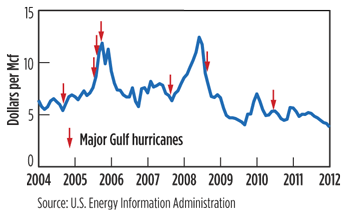What's new in production
Natural gas–always the bridesmaid?
Is the price of natural gas too low? That depends on whom you ask. Ask the hungry man if the price of food is too low. Natural gas is cheaper than it’s been in 10 years, stockpiles are abundant, and we have a hundred years of reserves (supposedly). Good news for everybody who uses gas. At these prices, is gas now poised to move from a marginal to a primary fuel for utilities and industry? Burned by gas. In a video posted online a couple of months ago by ConocoPhillips (part of the company’s very fine “Speaking of Natural Gas” series), chief economist Marianne Kah addressed the issue in quite clear terms. She pointed out that with the advent of the Clean Air Act, there was a surge in construction of gas-fired power plants. This appeared to be common sense at the time, because throughout the 1940s through the ’60s, the U.S. flared a large part of its natural gas production. Gas was cheap, and an easy way to meet emissions standards. Then, U.S. gas production went into decline and prices rose, and the utility industry mothballed a lot of its capacity. As Ms. Kah put it, “Our customers are asking us, ‘why should we believe you NOW?’” Because, she argues, the days of extreme volatility of gas prices may be over. “Volatility,” in this case, means short-term volatility, week-to-week or month-to-month. You can’t get rid of gas price volatility completely, because gas is a commodity. Commodities react to events, such as wars, world crises or weather. Natural gas plants are the cheapest to build, but have the highest variable cost. Natural gas is the fuel used to meet demand surges. Utilities can’t know in advance how much gas they’ll need. It is unfair to blame gas for price volatility, because no other fuel can fill its role. But a less-volatile future is likely for several reasons: Storage. The U.S. has much greater storage capacity than in the past. LNG. Liquified natural gas can be imported from anywhere in the world, up to 25% of demand (18 Bcfd), on short notice. Pipelines. Transportation capacity is higher than it has ever been. We can get it where it needs to go. Supply. What is being called the “shale gas revolution” has made gas supply more like a manufacturing process—it is relatively easy to ramp up production. These are not the deep gas plays with high risk and years of lead time. Weather-resistance. Production growth is all onshore, and not as susceptible to weather events. “Most of our price spikes, historically, have been caused by hurricanes,” Kah said. Those large-scale weather disruptions should be mostly over today. Hurricanes do not often threaten Wyoming. That last point was interesting, and I wondered how significant hurricanes have been in affecting gas prices. We pulled up a gas-price chart from EIA and put in little arrows wherever there was a “significant” hurricane in the Gulf of Mexico (one that disrupted production), just for the past 10 years (see figure). The graph is by month to smooth out short-term spikes. We haven’t put the names in, but everybody knows them. Most obvious is the evil triumvirate of 2005, Emily, Katrina and Rita. The disruption to supply was severe and sustained, and prices reacted accordingly, peaking in October at $10.33/Mcf. Two storms in August ’07 were disruptive enough to push prices up just as surging demand was pulling from the other end. The decade’s price peak came in July 2008 at $10.79/Mcf, before beginning its most vertigo-inducing fall in history. Hurricane Ike, in September ’08, was a monster of a storm, causing severe damage both offshore and on, and a significant supply disruption. As can be seen in the chart, it didn’t make gas prices blink. Nothing made a difference in the long death-spiral that was the world economy in the fall of 2008. Maybe hurricanes really are losing their punch. Pass the PUC. The video’s final point is that a major factor that makes utilities reluctant to utilize gas as a primary fuel is state government policies. States do not allow utilities to manage gas-price risk. Gas is at a disadvantage relative to coal and nuclear, for example, because for these fuels, utilities pass the costs through once, then the variable fuel costs are low. “You don’t have to talk to the public utility commission after that,” Kah said. “With natural gas, you may be talking to the PUC every month about whether you purchased gas prudently or not.” When a utility hedges its risk, the PUC may conclude the move was NOT prudent, and not allow them to pass their costs through. This creates a real barrier to reliance on gas. Enter the EPA. In March, the Environmental Protection Agency issued new standards on CO2 that address future power plants. Under the new rules, new power plants of 25 MW or more that use fossil fuels are restricted to 1,000 lb of CO2 emissions per megawatt hour. This is a standard easily met with natural gas and a real bugaboo for coal-fired plants, which put out 1,700–1,800 lb/MWh of CO2 without the benefit of expensive scrubbing. Although the rule exempts existing coal plants and those currently permitted, it puts future coal-fueled utilities at a severe disadvantage. Other energy sources, nuclear as well as wind and solar, will benefit in coming years if the rules stand. But it’s natural gas that may become the loudest bridesmaid at the wedding party. Will it ever get to walk down the aisle?
|
- What's new in production (February 2024)
- Prices and governmental policies combine to stymie Canadian upstream growth (February 2024)
- U.S. operators reduce activity as crude prices plunge (February 2024)
- U.S. producing gas wells increase despite low prices (February 2024)
- U.S. drilling: More of the same expected (February 2024)
- U.S. oil and natural gas production hits record highs (February 2024)
- Applying ultra-deep LWD resistivity technology successfully in a SAGD operation (May 2019)
- Adoption of wireless intelligent completions advances (May 2019)
- Majors double down as takeaway crunch eases (April 2019)
- What’s new in well logging and formation evaluation (April 2019)
- Qualification of a 20,000-psi subsea BOP: A collaborative approach (February 2019)
- ConocoPhillips’ Greg Leveille sees rapid trajectory of technical advancement continuing (February 2019)




